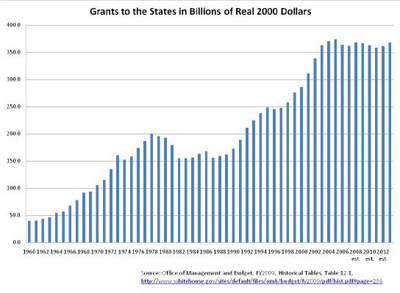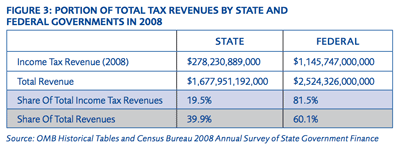- | F. A. Hayek Program F. A. Hayek Program
- | Government Spending Government Spending
- | Policy Briefs Policy Briefs
- |
The Death of Fiscal Federalism
In May 2009, the federal government forced South Carolina Governor Mark Sanford to take his state's share of federal stimulus funds and spend the money on new programs rather than on paying down debt.
In May 2009, the federal government forced South Carolina Governor Mark Sanford to take his state's share of federal stimulus funds and spend the money on new programs rather than on paying down debt. Many free-market advocates claimed this alarming move threatened the fiscal federalism,1 but fiscal federalism has been threatened for decades. The growth of the federal government and its ever-increasing number of grants and subsidies to state governments have eroded fiscal federalism and competition among states substantially.2
WHAT IS FISCAL FEDERALISM?
Fiscal federalism is the idea that, acting under some federal constraints, states should set their own economic policies rather than follow directives from the central government.3 A limit on federal power, fiscal federalism theoretically produces one main benefit to individuals: it increases competition between states. If states differentiate themselves on the basis of taxes, spending, and regulation, Americans have more freedom to decide the rules under which they live. If citizens are dissatisfied with the state in which they reside, they can register their discontent by voting with their feet and moving to another jurisdiction.4 This competition for residents helps keep lawmakers in check, giving them an incentive to keep taxes, regulations, and other intrusions modest.
Also, by nature, the policy needs and priorities in the state of Alaska are different than those in the state of Florida. Fiscal federalism involves decentralization of decision making, which allows sovereign states to cater to their constituencies' preferences and provide policies that fit their states rather than impose a one-size-fit-all product.
THE EROSION OF FISCAL FEDERALISM
The precondition for fiscal federalism to work is that taxpayers get a different tax treatment or burden depending on where they live. For decades, however, the federal government has taken over many state functions, essentially eroding federalism by making state policy more homogenous. This process happened mainly through the federal distribution of grants to state and local governments, also called grants-in-aids. Figure 1 shows federal grant spending in constant (2000) dollars from 1960 to 2013. Total grant outlays increased from $285.9 billion in fiscal year 2000 to $363.3 billion in fiscal year 2010—a 27.1 percent increase. Grants also account for a bigger share of federal spending: 18 percent in 2009, compared to 7.6 percent in 1960. The data shows the federal government taking over more and more state activities, such as education.
The same pattern in the takeover of state functions by the federal government is evident when you look at the total number of federal grant programs (see figure 2). According to data computed by Cato Institute's Chris Edwards, in 1980 there were 434 federal grant programs for state and local governments. In 2006 there were 814.5
Edwards notes that the support for grants and for centralization of government power in Washington come from policy makers who favor funding government thought the heavily graduated federal income tax system rather than through the more proportional state tax system. Hence, as federal grant programs continue to grow, so does federal taxation.
Federal taxation has grown so much that differences in state tax rates marginally affect the total tax burden. As figure 3 shows, 60 percent of all government revenues in 2008 came from the federal income tax, making it the dominant tax burden in Americans' lives. By contrast, in 1930, the federal income tax provided only 30 percent of all government revenues.6
All other things being equal, it remains less costly to live or run a business in a low-tax rate state than in a high-tax rate one. However, when the central government imposes an ever-increasing percentage of each taxpayer's total tax burden, differences in state taxes become less important. In other words, if your main tax burden is going to be the same wherever you live, why bother even moving to another state, especially if you get to deduct your state taxes from your federal ones? Being able to deduct state taxes from the federal burden obviates any differences between the states.
Federal grants for state and local functions also obviate any differences between the states. Such grants come with strings attached, strings that further weaken states' independence. In order to retrieve some of the money that their residents have paid in federal taxes, states must compete with each other to get money from the federal government instead of more directly competing with each other to gain residents.
This lack of meaningful interstate competition has a negative effect on taxpayers. As programs become more centralized, state authorities must increasingly comply with procedures and regulations set forth by Washington. These homogeneous procedures and regulations often ignore the needs of local taxpayers. In effect, the states and the federal government act as a tax cartel, charging higher taxes for lower quality services that do not address the unique needs of communities.
POLICY IMPLICATIONS AND CONCLUSION
In theory, fiscal federalism is a great tool that holds state and local governments accountable for their policy actions. In practice, it hardly exists. The increasing scope of federal programs and grants has largely eroded its impact on policy decisions by state and local government to the point that tax considerations become almost irrelevant in people's decisions about where to live.
We should mourn the death of fiscal federalism. While fiscal competition between states gives an incentive to policymakers to keep taxes, regulations, and other intrusions modest by fear of losing taxpayers to another tax jurisdiction, homogenized, top-down policy removes the constraints on the states to fight to keep its residents.
Instead of competing for residents, states are competing for central government funding and privileges. Such activity breeds wasteful spending and rent-seeking, which are drains on the welfare of American society.7
In order to bring fiscal federalism back to life, we need to radically decentralize the government's power to tax and to spend. The Reagan administration's policy of "new federalism" attempted to sort out the mess of federal grants by redefining federal and state priorities so that each level of government should have full responsibility for financing its own programs. For example, the Omnibus Budget Reconciliation Act of 1981 eliminated 59 grant programs and consolidated 80 narrowly focused grants into 9 block grants, reducing their regulatory burden.8 Unfortunately, this progress was subsequently reversed.
Today, lawmakers need to revive federalism by transferring many programs back to the states. States are, after all, in a better position than the federal government to determine their needs when it comes to roads or schools.
A first step would be to dramatically cut federal aid to the state governments. Eventually, the federal government would have to abolish the national income tax and cease giving grants to state and local governments. Only such circumstances would expel the authority of central government from state and local functions and force lawmakers to cajole their constituents for fear of losing residents to competing states.
ENDNOTES
1. "White House rejects request to use stimulus to pay off state debt," CNN: Politics, March 16, 2009, http://www.cnn.com/2009/POLITICS/03/16/south.carolina.stimulus/index.ht…; "South Carolina governor trumped, must take stimulus money," CNN: Politics, June 4, 2009, http://www.cnn.com/2009/POLITICS/06/04/south.carolina.sanford.stimulus/….
2. This policy essay is based on Veronique de Rugy,"The Death of Fiscal Federalism: It's been a long time since economic policy was forged in the states," Reason Magazine, April 2010 (Online: March 17, 2010), http://reason.com/archives/2010/03/17/the-death-of-fiscal-federalism.
3. Peter Ozo-Eson,"Fiscal Federalism: Theory, Issues and Perspectives," Daily Independent, August 2005. http://www.dawodu.com/eson1.htm.
4. The concept of voting with your feet was developed by Charles Tiebout: Charles Tiebout, "A Pure Theory of Local Expenditures," Journal of Political Economy 64, no. 5 (1956): 416-24.
5. Chris Edwards, "Number of Federal Subsidy Programs is Soaring," Tax & Budget Bulletin, no. 14, Cato Institute: Washington, DC, October 2006, http://www.cato.org/pubs/tbb/tbb_0611-41.pdf; Chris Edwards, "Number of Federal Subsidy Programs Top 1800," Tax & Budget Bulletin, no. 56, Cato Institute: Washington, DC, April 2009, http://www.cato.org/pubs/tbb/tbb_56.pdf.
6. Dwight Lee,"Reverse Revenue Sharing: A Return to Fiscal Federalism," Cato Journal 14, no. 1, Cato Institute: Washington, DC, October 1994, http://www.cato.org/pubs/journal/cj14n1-7.html.
7. Chris Edwards, "Fiscal Federalism," Cato Handbook for Policymakers,(7th ed.), ch. 5, Cato Institute: Washington, DC.
8. Ibid,138.
To speak with a scholar or learn more on this topic, visit our contact page.




